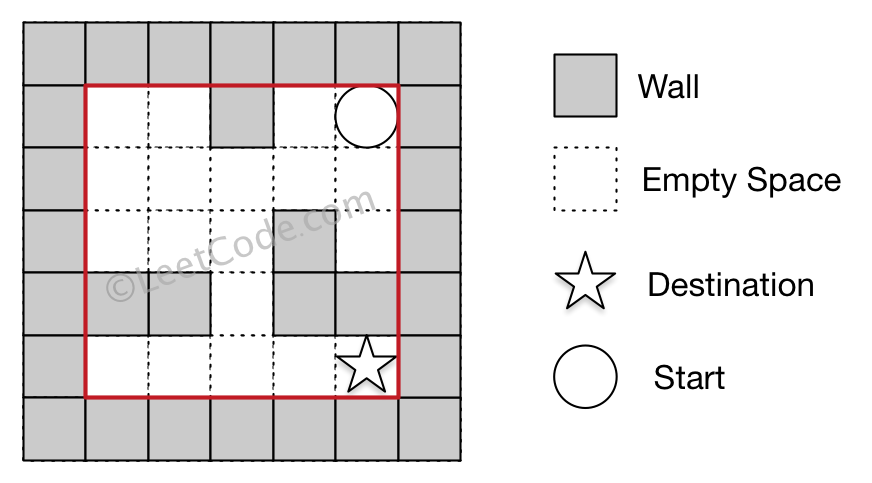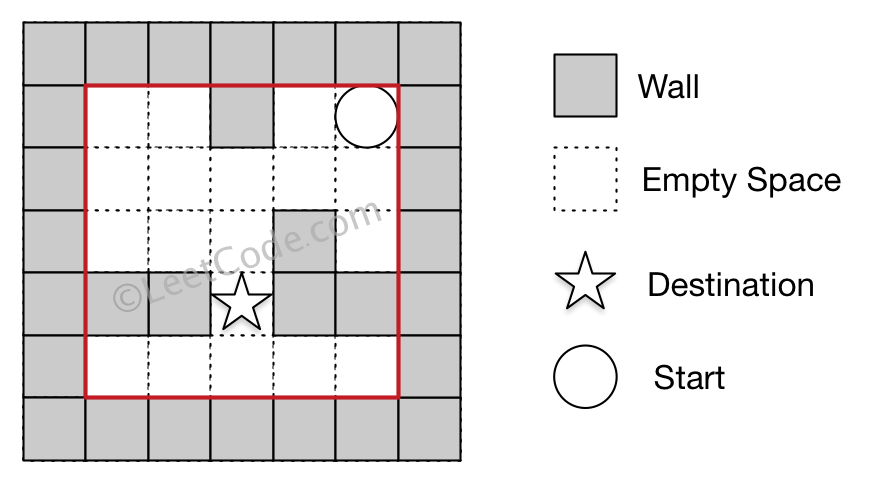[LeetCode] The Maze II 迷宫之二
There is a ball in a maze with empty spaces and walls. The ball can go through empty spaces by rolling up, down, left or right, but it won't stop rolling until hitting a wall. When the ball stops, it could choose the next direction.
Given the ball's start position, the destination and the maze, find the shortest distance for the ball to stop at the destination. The distance is defined by the number of empty spaces traveled by the ball from the start position (excluded) to the destination (included). If the ball cannot stop at the destination, return -1.
The maze is represented by a binary 2D array. 1 means the wall and 0 means the empty space. You may assume that the borders of the maze are all walls. The start and destination coordinates are represented by row and column indexes.
Example 1
Input 1: a maze represented by a 2D array 0 0 1 0 0
0 0 0 0 0
0 0 0 1 0
1 1 0 1 1
0 0 0 0 0 Input 2: start coordinate (rowStart, colStart) = (0, 4)
Input 3: destination coordinate (rowDest, colDest) = (4, 4) Output: 12
Explanation: One shortest way is : left -> down -> left -> down -> right -> down -> right.
The total distance is 1 + 1 + 3 + 1 + 2 + 2 + 2 = 12.

Example 2
Input 1: a maze represented by a 2D array 0 0 1 0 0
0 0 0 0 0
0 0 0 1 0
1 1 0 1 1
0 0 0 0 0 Input 2: start coordinate (rowStart, colStart) = (0, 4)
Input 3: destination coordinate (rowDest, colDest) = (3, 2) Output: -1
Explanation: There is no way for the ball to stop at the destination.

Note:
- There is only one ball and one destination in the maze.
- Both the ball and the destination exist on an empty space, and they will not be at the same position initially.
- The given maze does not contain border (like the red rectangle in the example pictures), but you could assume the border of the maze are all walls.
- The maze contains at least 2 empty spaces, and both the width and height of the maze won't exceed 100.
这道题是之前那道 The Maze 的拓展,那道题只让我们判断能不能在终点位置停下,而这道题让求出到达终点的最少步数。其实本质都是一样的,难点还是在于对于一滚到底的实现方法,唯一不同的是,这里用一个二位数组 dists,其中 dists[i][j] 表示到达 (i,j) 这个位置时需要的最小步数,都初始化为整型最大值,在后在遍历的过程中不断用较小值来更新每个位置的步数值,最后来看终点位置的步数值,如果还是整型最大值的话,说明没法在终点处停下来,返回 -1,否则就返回步数值。注意在压入栈的时候,对x和y进行了判断,只有当其不是终点的时候才压入栈,这样是做了优化,因为如果小球已经滚到终点了,就不要让它再滚了,就不把终点位置压入栈,免得它还滚,参见代码如下:
解法一:
class Solution {
public:
int shortestDistance(vector<vector<int>>& maze, vector<int>& start, vector<int>& destination) {
int m = maze.size(), n = maze[].size();
vector<vector<int>> dists(m, vector<int>(n, INT_MAX));
vector<vector<int>> dirs{{,-},{-,},{,},{,}};
queue<pair<int, int>> q;
q.push({start[], start[]});
dists[start[]][start[]] = ;
while (!q.empty()) {
auto t = q.front(); q.pop();
for (auto d : dirs) {
int x = t.first, y = t.second, dist = dists[t.first][t.second];
while (x >= && x < m && y >= && y < n && maze[x][y] == ) {
x += d[];
y += d[];
++dist;
}
x -= d[];
y -= d[];
--dist;
if (dists[x][y] > dist) {
dists[x][y] = dist;
if (x != destination[] || y != destination[]) q.push({x, y});
}
}
}
int res = dists[destination[]][destination[]];
return (res == INT_MAX) ? - : res;
}
};
上面这种解法的 DFS 形式之前是可以通过 OJ 的,但是现在被卡时间过不了了,代码可以参见评论区第二十三楼。我们还可以使用迪杰斯特拉算法 Dijkstra Algorithm 来做,LeetCode 中能使用到此类高级算法的时候并不多,Network Delay Time 就是一次。该算法是主要是在有向权重图中计算单源最短路径,即单个点到任意点到最短路径。因为这里起点只有一个,所以适用,然后迷宫中的每个格子都可以看作是图中的一个结点,权重可以都看成是1,那么就可以当作是有向权重图来处理。Dijkstra 算法的核心是松弛操作 Relaxtion,当有对边 (u, v) 是结点u到结点v,如果 dist(v) > dist(u) + w(u, v),那么 dist(v) 就可以被更新,这是所有这些的算法的核心操作。Dijkstra 算法是以起点为中心,向外层层扩展,直到扩展到终点为止。那么看到这里,你可能会有个疑问,到底 Dijkstra 算法和 BFS 算法究竟有啥区别。这是个好问题,二者在求最短路径的时候很相似,但却还是有些区别的。首先 Dijkstra 算法是求单源点的最短路径,图需要有权重,而且权重值不能为负,这道题中两点之间的距离可以看作权重,而且不会为负,满足要求。而 BFS 算法是从某点出发按广度优先原则依次访问连通的结点,图可以无权重。另外一点区别就是,BFS 算法是将未访问的邻居压入队列,然后再将未访问邻居的未访问过的邻居入队列再依次访问,而 Dijkstra 算法是在剩余的为访问过的结点中找出权重最小的并访问,这就是为什么要用一个优先队列(最小堆)来代替普通的 queue,这样就能尽量先更新离起点近的位置的 dp 值,优先队列里同时也存了该点到起点的距离,这个距离不一定是最短距离,可能还能松弛。但是如果其 dp 值已经小于优先队列中保存的距离,那么就不必更新其周围位置的距离了,因为优先队列中保存的这个距离值不是最短的,使用它来更新周围的 dp 值没有意义。这相当于利用了松弛操作来进行剪枝,大大提高了运算效率,之后就是类似于之前的 BFS 的操作了,遍历其周围的四个位置,尝试去更新其 dp 值。最后还是跟之前一样,如果遍历到了终点,就不要再排入队列了,因为已经得到需要的结果了,参见代码如下:
解法二:
class Solution {
public:
int shortestDistance(vector<vector<int>>& maze, vector<int>& start, vector<int>& destination) {
int m = maze.size(), n = maze[].size();
vector<vector<int>> dists(m, vector<int>(n, INT_MAX));
vector<vector<int>> dirs{{,-},{-,},{,},{,}};
auto cmp = [](vector<int>& a, vector<int>& b) {
return a[] > b[];
};
priority_queue<vector<int>, vector<vector<int>>, decltype(cmp) > pq(cmp);
pq.push({start[], start[], });
dists[start[]][start[]] = ;
while (!pq.empty()) {
auto t = pq.top(); pq.pop();for (auto dir : dirs) {
int x = t[], y = t[], dist = dists[t[]][t[]];
while (x >= && x < m && y >= && y < n && maze[x][y] == ) {
x += dir[];
y += dir[];
++dist;
}
x -= dir[];
y -= dir[];
--dist;
if (dists[x][y] > dist) {
dists[x][y] = dist;
if (x != destination[] || y != destination[]) pq.push({x, y, dist});
}
}
}
int res = dists[destination[]][destination[]];
return (res == INT_MAX) ? - : res;
}
};
Github 同步地址:
https://github.com/grandyang/leetcode/issues/505
类似题目:
参考资料:
https://leetcode.com/problems/the-maze-ii/
https://leetcode.com/problems/the-maze-ii/discuss/98401/java-accepted-dfs
https://leetcode.com/problems/the-maze-ii/discuss/98456/simple-c-bfs-solution
LeetCode All in One 题目讲解汇总(持续更新中...)
[LeetCode] The Maze II 迷宫之二的更多相关文章
- [LeetCode] 505. The Maze II 迷宫之二
There is a ball in a maze with empty spaces and walls. The ball can go through empty spaces by rolli ...
- [LeetCode] 505. The Maze II 迷宫 II
There is a ball in a maze with empty spaces and walls. The ball can go through empty spaces by rolli ...
- [LeetCode] The Maze III 迷宫之三
There is a ball in a maze with empty spaces and walls. The ball can go through empty spaces by rolli ...
- [LeetCode] 47. Permutations II 全排列之二
Given a collection of numbers that might contain duplicates, return all possible unique permutations ...
- [LeetCode] Meeting Rooms II 会议室之二
Given an array of meeting time intervals consisting of start and end times [[s1,e1],[s2,e2],...] (si ...
- [LeetCode] House Robber II 打家劫舍之二
Note: This is an extension of House Robber. After robbing those houses on that street, the thief has ...
- Leetcode: The Maze II
There is a ball in a maze with empty spaces and walls. The ball can go through empty spaces by rolli ...
- [LeetCode] 499. The Maze III 迷宫 III
There is a ball in a maze with empty spaces and walls. The ball can go through empty spaces by rolli ...
- [LeetCode] The Maze 迷宫
There is a ball in a maze with empty spaces and walls. The ball can go through empty spaces by rolli ...
随机推荐
- [react 基础篇]——React.createClass()方法同时创建多个组件类
react 组件 React 允许将代码封装成组件(component),然后像插入普通 HTML 标签一样,在网页中插入这个组件.React.createClass 方法就用于生成一个组件类 一个组 ...
- Matlab绘图基础——其他三维图形(绘制填充的五角星)
其他三维图形 %绘制魔方阵的三维条形图 subplot(2,2,1); bar3(magic(4)); %以三维杆图形式绘制曲线y=2sin(x) subplot(2,2,2); y=2*sin( ...
- runtime.getruntime.availableprocessors
1:获取cpu核心数: Runtime.getRuntime().availableProcessors(); 创建线程池: Executors.newFixedThreadPool(nThreads ...
- virtualbox主机与虚拟机之间互相通信教程
前言 在使用虚拟机搭建集群时,需要实现虚拟机与虚拟机之间互相ping通,并且主机与虚拟机也可以互相ping通. 一.环境准备: 1.主机为win7 2.virtualbox下创建两台ubuntu虚拟机 ...
- 数据库ACID,SQL和NoSQL
数据库中的事务(transaction)有ACID4个基本特性,可以类比交易: 1,A(Atomicity)原子性 事务里的事情要么全部做完,要么执行过程中失败,此时回滚. 2,C(Consisten ...
- windows环境下,apache虚拟主机配置
在windows环境下,apache从配置文件的相关配置: Windows 是市场占有率最高的 PC 操作系统, 也是很多人的开发环境. 其 VirtualHost 配置方法与 Linux 上有些差异 ...
- Scrum 冲刺 第五日
目录 要求 项目链接 燃尽图 问题 今日任务 明日计划 成员贡献量 要求 各个成员今日完成的任务(如果完成的任务为开发或测试任务,需给出对应的Github代码签入记录截图:如果完成的任务为调研任务,需 ...
- 项目Beta冲刺Day1
项目进展 李明皇 今天解决的进度 点击首页list相应条目将信息传到详情页 明天安排 优化信息详情页布局 林翔 今天解决的进度 前后端连接成功 明天安排 开始微信前端+数据库写入 孙敏铭 今天解决的进 ...
- 顺企网 爬取16W数据保存到Mongodb
import requests from bs4 import BeautifulSoup import pymongo from multiprocessing.dummy import Pool ...
- 【TensorFlow随笔】关于一个矩阵与多个矩阵相乘的问题
问题描述: Specifically, I want to do matmul(A,B) where 'A' has shape (m,n) 'B' has shape (k,n,p) and t ...
